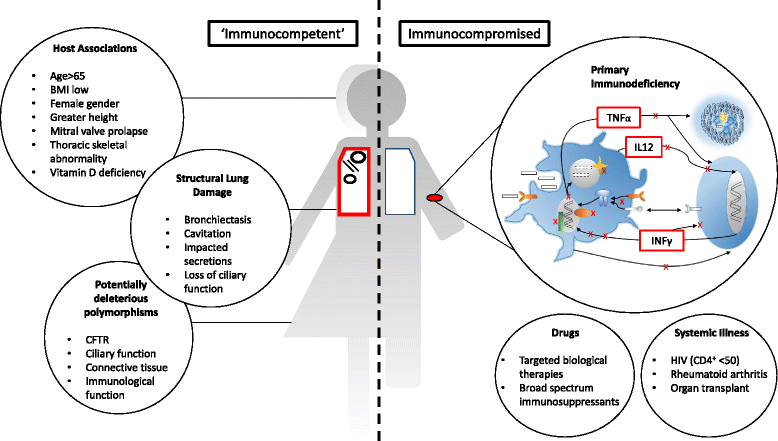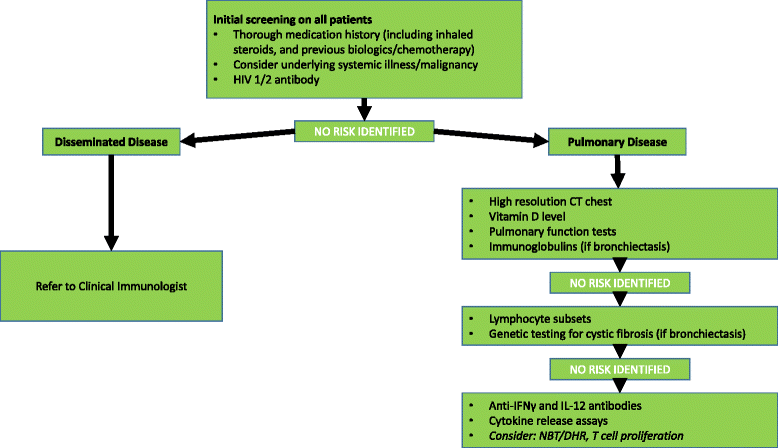'"Why me, why now?" Using clinical immunology and epidemiology to explain who gets nontuberculous mycobacterial infection
- PMID: 27007918
- PMCID: PMC4806462
- DOI: 10.1186/s12916-016-0606-6
'"Why me, why now?" Using clinical immunology and epidemiology to explain who gets nontuberculous mycobacterial infection
Abstract
Background: The prevalence of nontuberculous mycobacterial (NTM) disease is rising. An understanding of known risk factors for disease sheds light on the immunological and physical barriers to infection, and how and why they may be overcome. This review focuses on human NTM infection, supported by experimental and in vitro data of relevance to the practising clinician who seeks to understand why their patient has NTM infection and how to further investigate.
Discussion: First, the underlying immune response to NTM disease is examined. Important insights regarding NTM disease susceptibility come from nature's own knockouts, the primary immune deficiency disorders. We summarise the current knowledge surrounding interferon-gamma (IFNγ)-interleukin-12 (IL-12) axis abnormalities, followed by a review of phagocytic defects, T cell lymphopenia and rarer genetic conditions known to predispose to NTM disease. We discuss how these define key immune pathways involved in the host response to NTM. Iatrogenic immunosuppression is also important, and we evaluate the impact of novel biological therapies, as well as bone marrow transplant and chemotherapy for solid organ malignancy, on the epidemiology and presentation of NTM disease, and discuss the host defence dynamics thus revealed. NTM infection and disease in the context of other chronic illnesses including HIV and malnutrition is reviewed. The role of physical barriers to infection is explored. We describe how their compromise through different mechanisms including cystic fibrosis, bronchiectasis and smoking-related lung disease can result in pulmonary NTM colonisation or infection. We also summarise further associations with host factors including body habitus and age. We use the presented data to develop an over-arching model that describes human host defences against NTM infection, where they may fail, and how this framework can be applied to investigation in routine clinical practice.
Keywords: Bronchiectasis; Cystic fibrosis; Host defence; Immune response; Interferon gamma; Interleukin 12; Nontuberculous mycobacteria; Primary immune deficiency.
Figures



Similar articles
-
What Immunological Defects Predispose to Non-tuberculosis Mycobacterial Infections?Iran J Allergy Asthma Immunol. 2018 Apr;17(2):100-109. Iran J Allergy Asthma Immunol. 2018. PMID: 29757583 Review.
-
Acquired and genetic host susceptibility factors and microbial pathogenic factors that predispose to nontuberculous mycobacterial infections.Curr Opin Immunol. 2018 Oct;54:66-73. doi: 10.1016/j.coi.2018.06.001. Epub 2018 Jun 21. Curr Opin Immunol. 2018. PMID: 29936307 Review.
-
Epidemiology of human pulmonary infection with nontuberculous mycobacteria.Clin Chest Med. 2002 Sep;23(3):553-67. doi: 10.1016/s0272-5231(02)00019-9. Clin Chest Med. 2002. PMID: 12370992 Review.
-
Highlight on advances in nontuberculous mycobacterial disease in North America.Biomed Res Int. 2014;2014:919474. doi: 10.1155/2014/919474. Epub 2014 Sep 11. Biomed Res Int. 2014. PMID: 25574470 Free PMC article. Review.
-
Underlying host risk factors for nontuberculous mycobacterial lung disease.Semin Respir Crit Care Med. 2013 Feb;34(1):110-23. doi: 10.1055/s-0033-1333573. Epub 2013 Mar 4. Semin Respir Crit Care Med. 2013. PMID: 23460011 Review.
Cited by
-
The Intriguing Pattern of Nontuberculous Mycobacteria in Bulgaria and Description of Mycobacterium bulgaricum sp. nov.Int J Mol Sci. 2024 Sep 27;25(19):10434. doi: 10.3390/ijms251910434. Int J Mol Sci. 2024. PMID: 39408759 Free PMC article.
-
Comorbidities associated with nontuberculous mycobacterial disease in Japanese adults: a claims-data analysis.BMC Pulm Med. 2020 Oct 9;20(1):262. doi: 10.1186/s12890-020-01304-6. BMC Pulm Med. 2020. PMID: 33036598 Free PMC article.
-
Nontuberculous Mycobacteria, Macrophages, and Host Innate Immune Response.Infect Immun. 2021 Jul 15;89(8):e0081220. doi: 10.1128/IAI.00812-20. Epub 2021 Jul 15. Infect Immun. 2021. PMID: 34097459 Free PMC article. Review.
-
Non-tuberculous mycobacterial pulmonary disease (NTM-PD): Epidemiology, diagnosis and multidisciplinary management.Clin Med (Lond). 2024 Jan;24(1):100017. doi: 10.1016/j.clinme.2024.100017. Epub 2024 Jan 17. Clin Med (Lond). 2024. PMID: 38387207 Free PMC article. Review.
-
Long-term successfull management of recurrent episodes of nontuberculous mycobacterial infection in an apparently healthy Chinese woman.Ann Clin Microbiol Antimicrob. 2024 Aug 3;23(1):68. doi: 10.1186/s12941-024-00732-0. Ann Clin Microbiol Antimicrob. 2024. PMID: 39097716 Free PMC article.
References
-
- Shah N, Davidson J, Anderson L, Lalor M, Kim J, Thomas H, et al. BMC Infectious Diseases Pulmonary Mycobacterium avium-intracellulare is the main driver of the rise in non-tuberculous mycobacteria incidence in England, Wales and Northern Ireland, 2007–2012. BMC Infect Dis. 2016. In Press. - PMC - PubMed
Publication types
MeSH terms
LinkOut - more resources
Full Text Sources
Other Literature Sources
Medical

